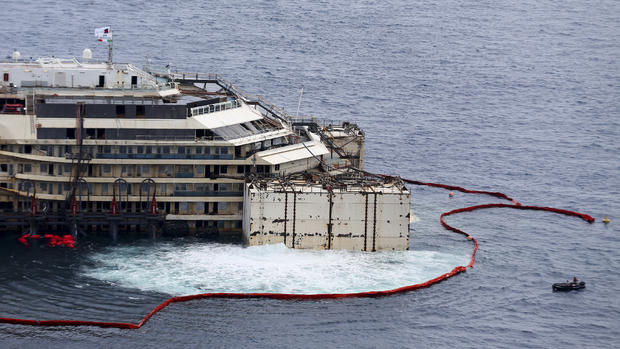Big and risky salvage operation: Costa Concordia cruise ship to be scrapped
GIGLIO, Italy - It took one act of incompetence to wreck the Costa Concordia, but it's taken two and a half years and about $1 billion to get to the point of getting rid of the wreck.
It's the biggest salvage operation ever attempted -- and one of the most risky, reports CBS News correspondent Mark Phillips. The Costa Concordia has been sitting upright on an underwater steel platform since last September.
Before that she had been lying on her side where she'd been grounded after hitting a rock while passing too close to the Italian island of Giglio, where 32 people died on the night of the accident. It took an unprecedented operation, what the salvagers call a parbuckling, to roll the ship over into a position where she can be refloated. But the engineering required to do that is impressive as well.
An array 30 metal flotation chambers have been attached along the sides of the ship. They're full of water now but are being pumped out so they can act as giant water wings and lift the Concordia. But it's never a simple as it sounds. The scale of the project is huge. The flotation chambers are the size of buildings.
"Very big lifts. We had eleven-story buildings, seven-story buildings, over eight hundred tons, so a lot of heavy lifts in a short time," director of the operation Nick Sloane said.
And only when the ship starts to move will the engineers be sure she still has the structural integrity to hold together under the strain.
Divers have been moving within the wreck, removing what they can, but the remains of one of the victims, a crew member on the ship, have never been found.
They're not taking any chances here. Engineering is one thing; help from other disciplines is welcome too.
"Hopefully we have thought of everything, but there's always something you haven't thought about which will raise its head," Sloane said.
The captain of the Costa Condordia, Francesco Schettino, is still on trial for his role in the disaster. He's accused of manslaughter and abandoning ship. With any luck, the evidence of the crime will be gone before the trial ends.
The plan is to raise the wreck just a couple of yards at first and then float her into slightly deeper water to check for leaks of toxic materials and secure the flotation chambers more securely. Only then will the Costa Concordia be raised another 30 feet or so and finally towed away. Around here they won't be sorry to see her go.
On Monday, authorities said they were satisfied that the operation to float the Concordia had proceeded without a hitch.
The plan is to tow the ship to Genoa, in northern Italy, where she'll be broken up for scrap. But even that is a risky operation, and there's still a good week's work here before they get to that point.
